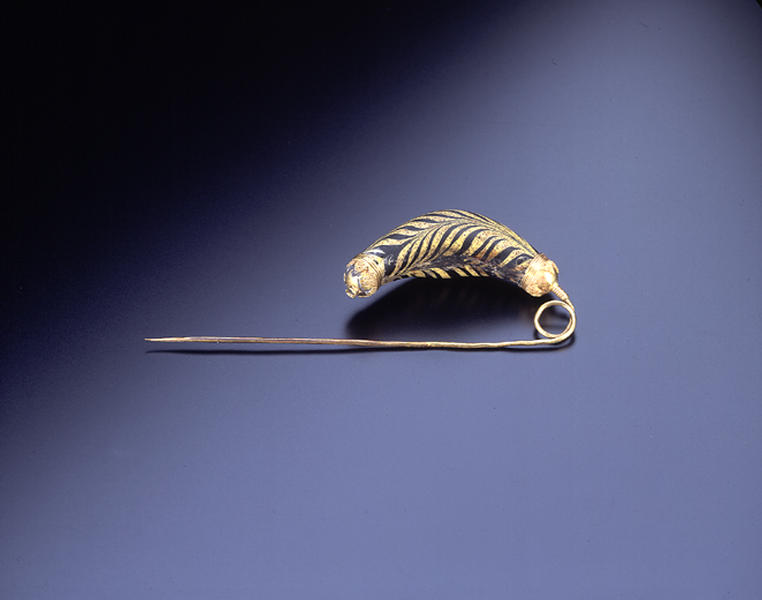フィブラ(ブローチ)
- エトルリア
- 紀元前7世紀
- ガラス
装飾部分にガラスを使った金製ブローチ。ガラスは、コア技法の一種といえるロッド技法で作られている。金属棒を薄く粘土などで覆って芯とし、熱したガラスを付着させて本体を作り、装飾を施した後に金属棒を引き抜いて完成させる方法である。細長いガラス容器やビーズ、ペンダント、ブローチ飾りなどを作るのに用いられた。本作品の割れ目から芯材を観察することができる。暗褐色の本体に巻き付けた黄色のガラス紐を引っ掻いて、背部中央に1列の垂綱文、その両側から腹部にかけてそれぞれ1対の羽状文を作り出している。文様の構成、施文ともに丁寧で美しい。細粒細工を施された金の留金に嵌め込まれているが、ピン受けが失われている。バルカン半島やイタリアの北部、中央部では前8世紀にガラス製作が開始され、最初はロッド技法によってブローチ飾り、腕輪、円筒形ビーズなどが作られた。この作品のようなブローチ飾りが前8世紀から前7世紀のエトルリアの墓から出土している。
Catalogue Entry
This gold brooch has glass in its decorative areas. The glass is a type of core technique glass known as the rod technique. A metal wire would be thinly coated in clay to form a core and then hot glass would have been applied to form the body. After the body was decorated, the metal rod would have been extracted to complete the process. This method was used to create long, thin glass vessels, beads, pendants, and brooch decorations. The central core material is observable in this work at its breaks. The dark brown body is wrapped in an attached yellow thread of glass and a single row of festoon pattern is on the back. A pair of feather patterns then extend along each side of this festoon pattern to the hip. The composition and patterns of the motifs are extremely delicately and beautifully handled. The glass was inlaid into the gold fastener, with glanulation but the pin holder has been lost. Glass production began on the Balkan peninsula and in northern and central Italy in the 8th century BC, and their first products were brooch decoration, armlets, and cylindrical beads made from the rod technique. This type of decorated brooch has been excavated from Etruscan tombs dating to the 8th - 7th centuries BC.
